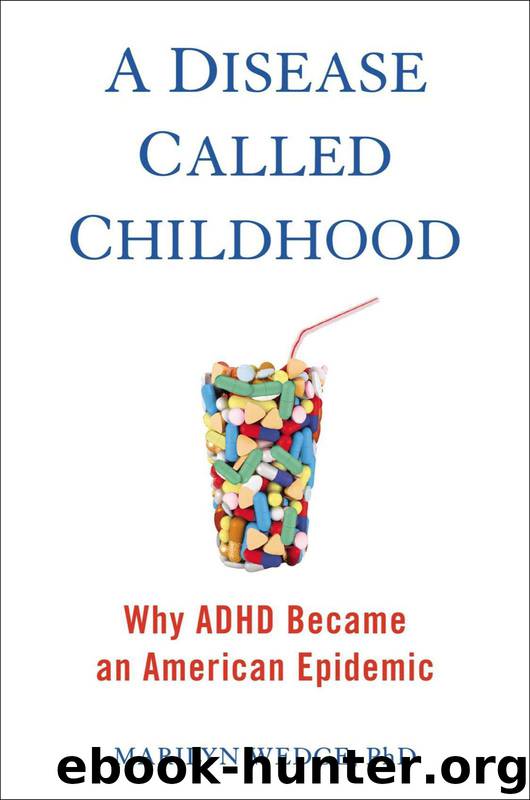A Disease Called Childhood: Why ADHD Became an American Epidemic by Marilyn Wedge

Author:Marilyn Wedge
Language: eng
Format: mobi
Tags: Sociology, Psychology
ISBN: 1101982888
Publisher: Avery
Published: 2015-03-23T22:00:00+00:00
Childhood Adversity
Gender and age both affect a child’s risk for being diagnosed with ADHD. But there are also more dire risk factors. Children who suffer severe family adversity or traumatic stress often develop behaviors such as impulsivity, hyperactivity, and inattentiveness. These experiences are known as ACEs (adverse childhood experiences) and may include emotional, sexual, or physical abuse or neglect, or living in a family situation that involves domestic violence, divorce, or substance abuse.
The landmark ACE study, sponsored by the Centers for Disease Control and Prevention in the 1990s, revealed that adverse childhood experiences, even among white upscale families, were far more prevalent than previously thought. This unexpected realization led neuroscientists to ask whether ACEs could go beyond behavioral effects and actually produce changes in children’s brains. In 2010, a team of researchers at the University of Wisconsin found that indeed they could do just that. After querying more than four thousand adults about ACEs in their early lives, the researchers found that negative early experiences led to poorer mental and physical health, poorer school and work success, and lower socioeconomic status in adulthood. This indicates that prolonged stress early in life can have long-term effects by changing the circuitry of a child’s brain.
How does this happen? Scientists found that over time elevated levels of stress hormones flood the brain and inhibit the prefrontal cortex, the part of the brain in which conscious learning takes place. Prolonged stress puts the brain into what scientists call a “fight, flight, or fright (freeze) mode,” weakening the brain’s other synaptic connections. This means that the social environment and the neurological map of the brain are connected and that children’s brains, which are especially “plastic” or malleable, are influenced by experience. A child can have a neurological problem that is caused not by a genetic predisposition toward a “chemical imbalance,” but by high levels of stress in his social environment. Modern neuroscience has thus closed the gap between nature and nurture. With respect to ADHD-type symptoms, those who insist that the problem is neurological and those who hold that the cause is environmental are both correct.
The ACE study inspired pediatricians in the United States to rethink their views about child development, giving more credence to the impact of environmental stressors. The authors of an article on the lifelong effects of childhood adversity and toxic stress, published in Pediatrics in 2012, suggest that it is time for a paradigm shift in pediatric medicine that gives environmental factors (nurture) more significance. They argue that the process of child development should no longer be viewed as primarily biological (nature) but as “nature dancing with nurture over time.” From infancy through childhood, development is driven by an interaction between a child’s genetic makeup and his social environment. As the new science of epigenetics is discovering, our early experiences get under our skins and into our brains, and they even impact the expression of our genomes.
Download
This site does not store any files on its server. We only index and link to content provided by other sites. Please contact the content providers to delete copyright contents if any and email us, we'll remove relevant links or contents immediately.
I Capture the Castle by Dodie Smith(1908)
Aspergirls by Rudy Simone(1586)
Be Different by John Elder Robison(1558)
Autism's False Prophets by Paul A. Offit(1450)
My Child's Different by Elaine Halligan(1429)
Smart but Scattered—and Stalled by Richard Guare(1415)
101 Tips for the Parents of Boys with Autism by Ken Siri(1384)
What's Making Our Children Sick? by Michelle Perro(1351)
Asperger Syndrome (Autism Spectrum Disorder) and Long-Term Relationships by Ashley Stanford(1333)
ADHD by Mark Selikowitz(1305)
Girlish by Lara Lillibridge(1294)
Nerdy, Shy, and Socially Inappropriate by Cynthia Kim(1272)
An Adult with an Autism Diagnosis by Gillan Drew(1267)
On Immunity: An Inoculation by Biss Eula(1247)
Animal-assisted Interventions for Individuals with Autism by Temple Grandin(1224)
Sarah's Child (Hqn Romance) by Linda Howard(1222)
Seeing Ezra by Kerry Cohen(1201)
Why Gender Matters by Leonard Sax M.D. Ph.D(1184)
The Cities by K.A Knight(1178)
